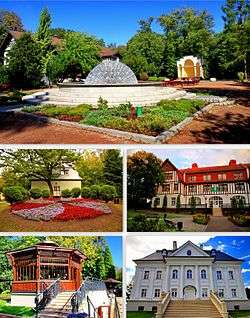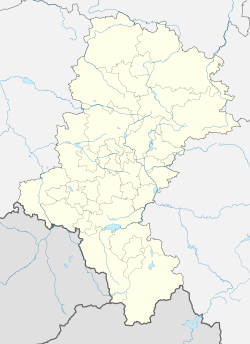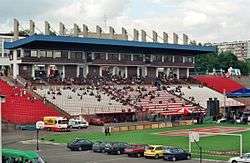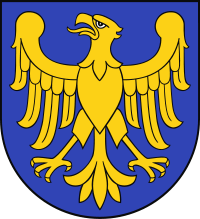Jastrzębie-Zdrój
Jastrzębie-Zdrój ([jasˈtʂɛmbʲɛ ˈzdruj] (![]()
Jastrzębie-Zdrój | |
|---|---|
 Top: Spa Park, Middle left: Museum, Middle right: University of Science and Technology, Bottom left: Spa Cafee, Bottom right: Borynia Palace. | |
 Flag  Coat of arms | |
| Motto(s): Jastrzębie-Zdrój – city of youth, work and peace | |
 Jastrzębie-Zdrój  Jastrzębie-Zdrój | |
| Coordinates: 49°57′N 18°35′E | |
| Country | |
| Voivodeship | |
| County | city county |
| Established | 14th century |
| Town rights | 1963 |
| Government | |
| • Mayor | Anna Hetman |
| Area | |
| • City | 85.44 km2 (32.99 sq mi) |
| Population (2018) | |
| • City | 89,128 |
| • Density | 1,043/km2 (2,700/sq mi) |
| • Metro | 650,000 |
| Time zone | UTC+1 (CET) |
| • Summer (DST) | UTC+2 (CEST) |
| Postal code | 44-330 to 44-335, 44-268 |
| Area code(s) | +48 32 |
| Car plates | SJZ |
| Website | http://www.jastrzebie.pl |
History
The first written documentation, relating to this area, date back to around 1305 (Liber fundationis episcopatus Vratislaviensis). Administratively, the town is made up of several old settlements, whose origins go back to the distant past. The original name of the town was Jastrzemb. The name's origin, means hawk in Polish language and is connected with the legend of the black knight. Since the XVI to the beginning of the XIX century part of Wodzisław state country. Between 1858–1860, trial excavations of hard coal were performed all over the area of Jastrzębie Dolne. These excavations ended up discovering springs containing iodine and bromine brine solutions. In 1860, the count of Königsdorff acquired the lands and suggested the construction of bath facilities. Thus, in 1862, the health resort of Bad Königsdorff-Jastrzemb was brought into life. Shortly after, the town joined the exclusive circle of the most prestigious health resorts in Europe.
In 1895, the natural health centre was taken over by a Polish doctor, Mikołaj Witczak, who lent great service to the development of health-resort in Bad Königsdorff-Jastrzemb. His managerial skills together with wise investment made Jastrzębie-Zdrój a highly appreciated and fashionable health resort inside the German Empire and the interbellum Poland. Consequently, numerous health facilities were then set up.
The history of Jastrzębie-Zdrój as a health resort came to its end in the 1960s, when all over the area began the intensive exploitation of coking coal deposits. Within a period of 12 years, 5 coal mines were set up. Between 1954–1975, Jastrzębie was part of the Wodzisław County. During the time of political transformation in Poland, Jastrzębie-Zdrój went down the annals of Polish modern history as the place where the so-called "the Jastrzębskie Agreement" was concluded. The signing of the protocol initiated the process of political, economic and social changes in Poland.
Population and location
The city itself had 91,723 inhabitants; its density is 1,047.9 per km² (as of January 31, 2012). Jastrzębie-Zdrój ranks as Poland's 36th largest city. Jastrzębie-Zdrój's unemployment rate is lower (7%) than the national average of 8.8% (as of November 2010).
Districts
Jastrzębie-Zdrój is a powiat (county) divided into 15 districts and 6 sołectwos that have its own administrative body. Most of the districts are suburban, some are densely built with many blocks of flats generating huge housing estates, and the rest are of civic nature.
- Arki Bożka (6,632 inhabitants)
- Barbary (10,185 inhabitants)
- Bogoczowiec (1,672 inhabitants)
- Chrobrego (5,042 inhabitants)
- Gwarków (8,126 inhabitants)
- Jastrzębie Górne i Dolne (4,369 inhabitants)
- Morcinka (4,534 inhabitants)
- Pionierów (11,210 inhabitants)
- Przyjaźń (4,718 inhabitants)
- Staszica (6,079 inhabitants)
- Tuwima (480 inhabitants)
- Tysiąclecia (3,242 inhabitants)
- Zdrój (7,682 inhabitants)
- Złote łany (1,118 inhabitants)
- Zofiówka (3,473 inhabitants)
Sołectwos:
- Borynia (1,918 inhabitants)
- Bzie (3,602 inhabitants)
- Moszczenica (3,026 inhabitants)
- Ruptawa (3,767 inhabitants)
- Skrzeczkowice (694 inhabitants)
- Szeroka (2,273 inhabitants)
Sports

- The most famous clubs
- GKS Jastrzębie – Polish professional football club, which plays at City Stadium Jastrzębie-Zdrój
- Jastrzębski Węgiel – men's volleyball team Polish Champion 2004 in Polish Volleyball League
- JKH GKS Jastrzębie – Polish professional ice hockey club, Polish Hockey Superleague
- Other clubs
Notable people
- Henryk Sławik (1894–1944), Polish politician, social worker, activist, and diplomat, who during World War II helped save over 30,000 Polish refugees, including 5,000 Polish Jews in Budapest, Hungary by giving them false Polish passports with Catholic designation
- Krystian Lupa (born 1943), Polish theatre director, set designer, playwright, translator and pedagogue
- Magdalena Lewy-Boulet (born 1973), American athlete
- Marcin Radzewicz (born 1980), Polish footballer
- Dariusz Kłus (born 1981), Polish footballer
- Łukasz Pielorz (born 1983), Polish footballer
- Kamil Glik (born 1988), Polish footballer
- Justyna Monde (born 1993), European model
Twin towns – sister cities
Jastrzębie-Zdrój is twinned with:[1]
References
- "Miasta partnerskie". jastrzebie.pl (in Polish). Jastrzębie-Zdrój. Retrieved 2020-03-10.
External links
- Municipal homepage
- Jewish Community in Jastrzębie-Zdrój on Virtual Shtetl
| Wikimedia Commons has media related to Jastrzębie-Zdrój. |
